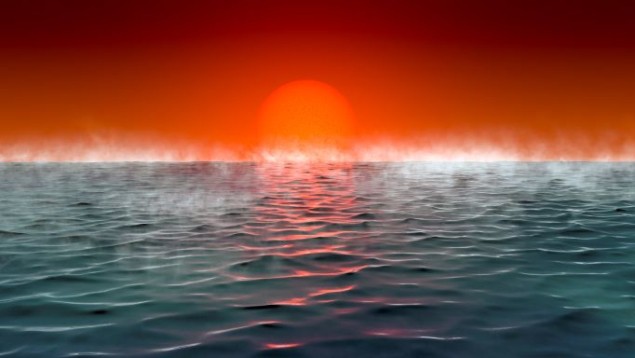
Hot, ocean-covered exoplanets with hydrogen-rich atmospheres could harbour life and may be more common than planets that are Earth-like in size, temperature and atmospheric composition. According to astronomers at the University of Cambridge, UK, this newly defined class of exoplanets could boost the search for life elsewhere in the universe by broadening the search criteria and redefining which biosignatures are important.
Astronomers define the habitable or “Goldilocks” zone as the region where an exoplanet is neither too close nor too far from its host star to have liquid water on its surface – water being the perfect solvent for many forms of life. Previous studies of planetary habitability have focused primarily on searching for Earth-like exoplanets and evidence that they could harbour the kind of chemistry found in life on Earth. However, it has so far proven difficult to detect atmospheric signatures from Earth-like planets orbiting Sun-like stars.
Potentially habitable mini-Neptunes
Larger exoplanets are easier to detect than smaller, Earth-sized ones, and exoplanets around 1.6‒4 times bigger than the Earth, with masses of up to 15 Earth masses and temperatures that in some cases exceed 2000 K, are relatively common. These planets are known as mini-Neptunes as they are similar to the ice giant planets in our solar system.
Previous studies suggested that the high pressures and temperatures beneath these planets’ hydrogen-rich atmospheres were incompatible with life. However, based on their analysis of an exoplanet called K2-18b, exoplanet scientist Nikku Madhusudhan and colleagues at Cambridge say that life could, in fact, exist on a subset of mini-Neptunes that meet specific criteria.
This subset, which the researchers dub “Hycean” (hydrogen + ocean) planets, consists of planets that have radii up to 2.6 times larger than Earth’s and are capable of harbouring vast oceans under atmospheres dominated by molecular hydrogen and water vapour. Such oceans could cover the whole planet and reach depths greater than the Earth’s oceans, and the researchers say that the conditions within them could be compatible with some forms of Earth-based microbial life. Hycean planets tidally locked with their host star could also exhibit habitable conditions on their permanent night side.
Widening the Goldilocks zone
Crucially, the researchers say that Hycean planets could be habitable even if they receive much less radiation from their host star than the Earth does from the Sun. This makes their Goldilocks zone far wider than it is for Earth-like planets, increasing the probability that life could exist and be detected there.

‘Hell-like’ exoplanet experiences rocky rain and supersonic wind
To determine whether an exoplanet qualifies as Hycean, Madhusudhan explains that the researchers must consider several factors, including mass, temperature and atmospheric properties. Once they determine that a Hycean candidate lies in the habitable zone for its host star, the next step is to search for molecular “signatures” that reveal its atmospheric and internal structures. This information might then be used to infer surface conditions such as whether the planet contains an ocean or signs of life. In the current study, published in The Astrophysical Journal, the researchers suggest that molecules such as methyl chloride, carbonyl sulphide, dimethyl sulphide and others that are produced by metabolic processes of microorganisms on Earth would all be relatively easy to detect on Hycean planets using spectroscopy.
The researchers claim that the results of this study increase the likelihood that such biosignatures could be found within the next two or three years. Several of the Hycean candidates they identified could, they suggest, be further investigated with instruments such as the James Webb Space Telescope (JWST) due to be launched later in 2021, as well as the ground-based Extremely Large Telescope (ELT). “Currently we don’t have any concrete evidence to estimate the prevalence and nature of life in the universe,” Madhusudhan says. “But we do think that there are a large number of potentially habitable exoplanets which can in principle host life.” Future observations with the JWST would, he adds, enable astronomers to characterize these planets’ atmospheres and detect biosignatures “if present”.



